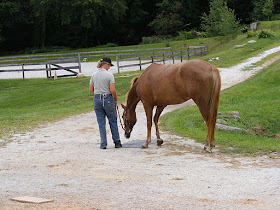 Apparently, from an equine perspective, there is a difference between black cows and black-and-white cows. We have Black Angus. The photo above shows some of our weanling calves, pastured about 75 feet from the horses. The horses see them daily and in the short lives of my youngsters, the cattle have been pastured on all sides. They hear them, see them, smell them and watch them daily. They watch them with interest, but not usually concern.
Apparently, from an equine perspective, there is a difference between black cows and black-and-white cows. We have Black Angus. The photo above shows some of our weanling calves, pastured about 75 feet from the horses. The horses see them daily and in the short lives of my youngsters, the cattle have been pastured on all sides. They hear them, see them, smell them and watch them daily. They watch them with interest, but not usually concern. Today, however, they saw black-and-white cows. Holsteins, to be precise. The neighbor's heifers got out and although they stayed on their own property, they came in sight of my horses. I had just put Percy in the round pen for a little training session and had gone to get the mats out when I noticed the heifers...or rather I noticed Percy notice the heifers. I called the neighbor (good friends) and he said he'd go fetch them back to where they belonged. It was a bit of a hike from his house to the far field that adjoined us where the heifers had wandered. It would be a few minutes at least. Percy was doing his Standing Stallion Statue pose as he watched the heifers at the bottom of the hill. Every 10 seconds or so, he'd terrrottt around the round pen very importantly only to freeze and stare some more. All the other horses were rooted to the spot in their paddocks as they watched the strange black and white creatures.
A training opportunity had arisen. I was in complete management control- he was in a safe place and so was I. I could see how much I was worth to him compared to the side show of Holsteins. I wasn't interested in forcing him to pay attention to me. I wanted to know just how much of a "cookie" I was. How much value had I built up? I had a pouch full of treats since I was about to work with him anyway so I was ready. I stood on the opposite side of the round pen- he was facing away from me- and I called him. He turned immediately and trotted to me. Well, that was impressive and earned him a people-peppermint (his favorite).
I can't remember exactly what order I did things in, but my mind was whirring as I tried to figure the best approach. I know I asked him to put his head down and he promptly did- C/T. He trusted me enough to relax into that- good. I considered working on 300 peck pigeon since I wasn't sure I wanted to get any more complicated than head down considering the distraction. I thought it would be good to see how long he would keep his head down in that situation. But then I realized that would break one of the 4 D rules. I didn't want to increase the criteria in more than one of the 4 Ds- distraction, distance, duration or difficulty. We already had Distraction to the extreme, so I didn't want to up the duration as well. I was also changing the cue on him a bit so I was really pushing things. Normally I place my hand on his poll for a non-rope cue for head down but because he was on the other side of the panels and was at high alert, I couldn't really reach his poll and was doing a modified cue of just raising my hand. He seemed to get it, but I needed to be careful to keep things successful even if it was a bit of a test.
So we did a bit of easy targeting, then some head down for a count of 5. He'd give me some good responses and then trot back to check on the heifers. After a couple seconds, he'd come back to me. I did not call him back to me after the first time. I was hoping for, and in fact I got, him to choose to come back and play with me. I'm not sure I was overwhelmingly more interesting than the heifers, because he did feel the need to go check on them regularly, but he did return to me each time on his own. I checked to see if he'd offer head down if I didn't cue him after we'd done it a couple times. He's currently offering Pilates moves when given the choice and I didn't want to encourage him to puff himself up any more so I went back to asking for head down or targeting. His eyes softened considerably and I was able to get a head down for count of 10. That was enough so that I decided to take the mats and go into the round pen with him for our original lesson plan.
By this time, the heifers had disappeared over the rise in the distant field. They were not forgotten, but I did have Percy's full cooperation. I was very pleased to notice improvement in his work from the previous day (we're working on a pre-riding pattern of three mats) even with the higher level of excitement. All in all, I was very pleased.



